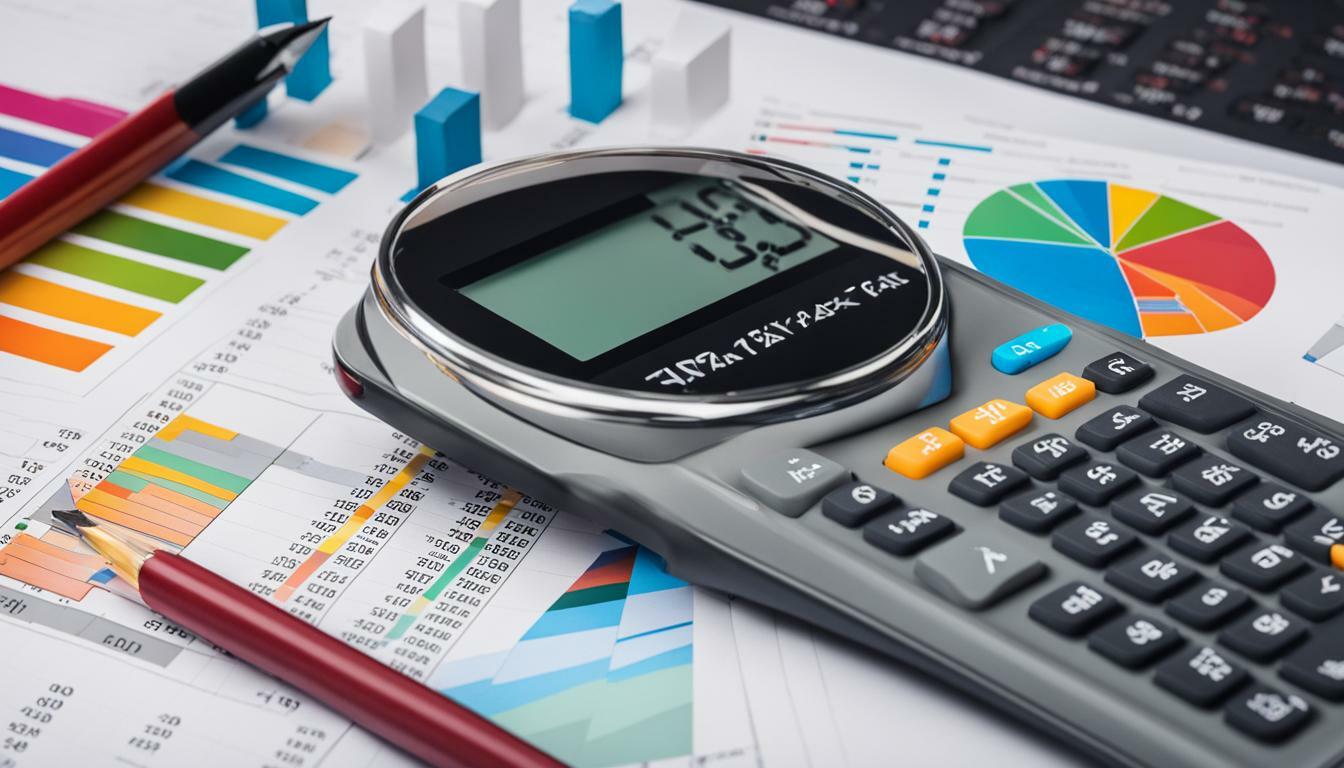The tax multiplier is a crucial tool in understanding the economic effects of changes in taxation. It measures the impact on a country’s GDP resulting from variations in tax rates. There are two versions of the tax multiplier: the simple tax multiplier and the complex tax multiplier. The simple tax multiplier formula is expressed as the negative marginal propensity to consume (MPC) divided by one minus MPC. The complex tax multiplier takes into account other components of GDP such as investments, imports, and taxes.
Key Takeaways:
- The tax multiplier measures the change in an economy’s GDP due to changes in taxes
- There are two versions of the tax multiplier: the simple tax multiplier and the complex tax multiplier
- The simple tax multiplier formula is Tax Multiplier = – MPC / (1 – MPC)
- The complex tax multiplier formula is Tax Multiplier = – MPC / [1 – (MPC x (1 – MPT) + MPI + MPG + MPM)]
- MPC, MPT, MPI, MPG, and MPM are factors that impact GDP
Table of Contents
What is the Tax Multiplier?
The tax multiplier is a measure of the relationship between changes in taxes and the resulting changes in the country’s GDP. It helps economists and policymakers understand the impact of tax policy changes on the overall economy.
There are two versions of the tax multiplier: the simple tax multiplier and the complex tax multiplier. The simple tax multiplier is calculated using the marginal propensity to consume (MPC). This MPC represents the change in consumption divided by the change in disposable income. The formula for the simple tax multiplier is Tax Multiplier = – MPC / (1 – MPC).
The complex tax multiplier takes into account various components of GDP, such as taxes, investments, and imports. It is calculated using the formula Tax Multiplier = – MPC / [1 – (MPC x (1 – MPT) + MPI + MPG + MPM)]. Here, MPT represents the marginal propensity to tax, MPI represents the marginal propensity to invest, MPG represents the marginal propensity to government spending, as well as MPM represents the marginal propensity to import.
Understanding the tax multiplier is crucial for effective financial planning. It enables policymakers and economists to assess the potential impact of tax changes on the economy. By calculating the tax multiplier, they can make informed decisions about tax policy adjustments and their consequences. Online calculators are available to simplify the tax multiplier calculation process. Which makes it easier to analyze the effects of tax changes on economic growth.
The Simple Tax Multiplier Formula
The simple tax multiplier is calculated using a formula that incorporates the marginal propensity to consume (MPC). MPC represents the change in consumption divided by the change in disposable income. To calculate the simple tax multiplier, you can use the following formula:
- Step 1: Determine the MPC value. This can be done by dividing the change in consumption by the change in disposable income.
- Step 2: Subtract the MPC value from 1 to find 1 minus MPC.
- Step 3: Divide the MPC value by 1 minus MPC.
- Step 4: Multiply the result by -1 to obtain the tax multiplier.
The formula for the simple tax multiplier can be expressed as:
The Simple Tax Multiplier Formula:
Tax Multiplier = - MPC / (1 - MPC)
By plugging in the appropriate values for MPC, you can easily calculate the tax multiplier. Moreover, you can also understand the relationship between changes in taxes and the resulting impact on the economy.
Understanding Marginal Propensity to Consume (MPC)
The marginal propensity to consume (MPC) is a crucial factor in determining the tax multiplier. MPC represents the change in consumption resulting from a change in disposable income. In simple terms, MPC measures the fraction of additional income that individuals choose to spend rather than save. A higher MPC indicates that individuals are more likely to spend a larger proportion of their additional income. Which will lead to a larger impact on the economy.
MPC is calculated by dividing the change in consumption by the change in disposable income. For example, if a $1,000 increase in disposable income leads to a $700 increase in consumption, the MPC would be 0.7 ($700/$1,000). The MPC value ranges between 0 and 1. Where 0 signifies no change in consumption and 1 indicates that all additional income is spent.
The MPC is an important determinant of the tax multiplier, as it directly affects the magnitude of the multiplier. A higher MPC means that a change in taxes will have a larger impact on consumption, leading to a greater change in GDP. On the other hand, a lower MPC will result in a smaller impact on consumption and a smaller change in GDP.
Determinants of Tax Multiplier
- Marginal Propensity to Save (MPS): The MPS represents the change in saving resulting from a change in disposable income. It is the complement of MPC, meaning that MPS = 1 – MPC. A higher MPS indicates a higher likelihood of individuals saving a larger portion of their additional income, leading to a smaller impact on consumption and GDP.
- Marginal Propensity to Invest (MPI): MPI represents the change in investment resulting from a change in disposable income. It indicates the extent to which businesses increase investment spending in response to higher disposable income. A higher MPI leads to a larger impact on GDP and a higher tax multiplier.
- Marginal Propensity to Import (MPM): MPM represents the change in imports resulting from a change in disposable income. It measures the proportion of additional income tax that individuals choose to spend on imported goods and services. A higher MPM means that a larger proportion of the change in income will leak out of the domestic economy, resulting in a smaller impact on GDP and a lower tax multiplier.
By understanding the MPC, MPS, MPI, and MPM, policymakers and economists can assess the impact of tax policy changes on the economy. These determinants of the tax multiplier help in forecasting the potential effects of tax changes and making informed decisions to promote economic growth.
The Complex Tax Multiplier Formula
The complex tax multiplier formula provides a more comprehensive calculation of the tax multiplier by considering additional components of GDP. It takes into account factors such as taxes, investments, and imports, offering a more accurate representation of the impact of tax changes on the economy.
The formula for the complex tax multiplier is as follows:
- Start with the negative marginal propensity to consume (MPC).
- Multiply the MPC by one minus the marginal propensity to tax (MPT).
- Add the marginal propensity to invest (MPI), marginal propensity to government spending (MPG), and marginal propensity to import (MPM) to the result.
- Finally, divide the result by one minus the sum of MPC multiplied by (1 – MPT), MPI, MPG, and MPM.
The resulting value is the tax multiplier, which represents the change in GDP resulting from changes in tax policy. The complex tax multiplier formula offers a more nuanced understanding of the impact of taxes on the economy by taking into account multiple factors that influence GDP.
Factors Impacting GDP
- Marginal propensity to consume (MPC): The change in consumption divided by the change in disposable income. It reflects how much individuals spend out of each additional dollar of income.
- Marginal propensity to tax (MPT): The change in taxes divided by the change in income. It represents the portion of additional income that is paid in taxes.
- Marginal propensity to invest (MPI): The change in investment divided by the change in income. It indicates the amount of additional income that is allocated towards investments.
- Marginal propensity to government spending (MPG): The change in government spending divided by the change in income. It accounts for the portion of additional income that is spent by the government.
- Marginal propensity to import (MPM): The change in imports divided by the change in income. It measures the amount of additional income that is used to purchase imported goods and services.
Understanding these factors is essential in calculating the tax multiplier accurately and comprehensively. They provide insights into the different components of GDP and help assess the overall impact of tax policy changes on the economy.
Factors Impacting GDP
Several factors, including MPC, MPM, MPS, and MPI, play a vital role in determining the tax multiplier and its impact on GDP. Let’s take a closer look at each of these factors:
- MPC (Marginal Propensity to Consume): MPC measures the change in consumption resulting from a change in disposable income. A higher MPC indicates that consumers are more likely to spend a larger portion of their income, leading to a larger tax multiplier and a greater impact on GDP.
- MPM (Marginal Propensity to Import): MPM represents the change in imports resulting from a change in income. If a country is more import-dependent, a higher MPM will lead to a smaller tax multiplier, as a significant portion of the increased income will be spent on imported goods.
- MPS (Marginal Propensity to Save): MPS refers to the change in savings resulting from a change in income. A higher MPS indicates that individuals are more inclined to save rather than spend, which results in a smaller tax multiplier and a lesser impact on GDP.
- MPI (Marginal Propensity to Invest): MPI measures the change in investment resulting from a change in income. Higher MPI values indicate that businesses are more willing to invest, leading to a larger tax multiplier and a greater impact on GDP.
These factors, along with changes in taxes, contribute to the overall tax multiplier and affect the magnitude of economic impact. It is essential for policymakers and economists to consider these determinants while analyzing the potential consequences of tax policy changes on the economy.
Calculating the Tax Multiplier
Calculating the tax multiplier involves several steps that can be executed using the simple tax multiplier formula. The simple tax multiplier is expressed as the negative marginal propensity to consume (MPC) divided by one minus MPC. To calculate the tax multiplier, follow these steps:
- Determine the value of the marginal propensity to consume (MPC), which is the change in consumption divided by the change in disposable income.
- Calculate the tax multiplier using the formula Tax Multiplier = – MPC / (1 – MPC).
The tax multiplier represents the change in a country’s GDP resulting from variations in tax rates. It helps policymakers and economists understand the impact of tax policy changes on the economy and make informed decisions. The simple tax multiplier formula provides a straightforward method for calculating the tax multiplier based on the MPC.
If you prefer a more comprehensive calculation, you can consider the complex tax multiplier formula. The complex tax multiplier takes into account other components of GDP such as investments, government spending, and imports. The formula is Tax Multiplier = – MPC / [1 – (MPC x (1 – MPT) + MPI + MPG + MPM)]. Here, MPT represents the marginal propensity to tax, MPI represents the marginal propensity to invest, MPG represents the marginal propensity of government spending, and MPM represents the marginal propensity to import.
To make the process easier, there are also online calculators available that can help you calculate the tax multiplier based on your inputs. These calculators take into account the necessary variables and provide you with the result. However, understanding the underlying formula and calculations is essential for accurate interpretation and analysis of the tax multiplier.
Example of Tax Multiplier Calculation
To better grasp the concept of tax multiplier calculation, let’s consider an example scenario and apply the formula to obtain the tax multiplier value.
Suppose there is a country where the marginal propensity to consume (MPC), which measures the change in consumption resulting from a change in disposable income, is 0.8. In this scenario, we will calculate the simple tax multiplier.
The formula for the simple tax multiplier is Tax Multiplier = – MPC / (1 – MPC). Plugging in the given value of MPC, we get Tax Multiplier = – 0.8 / (1 – 0.8).
Simplifying the equation, we find that the tax multiplier equals -4. This means that for every dollar decrease in taxes, the country’s GDP will increase by $4. Conversely, for every dollar increase in taxes, the GDP will decrease by $4.
The Significance of Tax Multiplier in Financial Planning
The tax multiplier holds significant value in financial planning, providing essential insights to policymakers and economists in assessing the potential effects of tax policy changes. By understanding and calculating the tax multiplier, decision-makers can make informed choices about tax rates and their impact on the overall economy. Here are some key points to consider:
- Measuring the impact: The tax multiplier helps quantify the impact of tax changes on the economy. It allows policymakers to assess how variations in tax rates influence consumer spending, investment, savings, and imports, which ultimately affect the Gross Domestic Product (GDP).
- Fine-tuning fiscal policies: By understanding the tax multiplier, policymakers can fine-tune fiscal policies to stimulate or stabilize economic growth. They can analyze the potential effects of tax cuts or increases on GDP and make adjustments accordingly.
- Evaluating trade-offs: Financial planners can use the tax multiplier to evaluate the trade-offs between tax policy changes and their impact on the economy. They can assess the potential benefits and drawbacks of implementing different tax strategies and make decisions that align with broader economic goals.
The Role of Tax Multiplier Calculation
Calculating the tax multiplier provides a quantitative measure of the potential effects of tax changes. It helps policymakers and economists understand how changes in tax rates influence consumer behavior and, consequently, economic output. The tax multiplier formula allows for a systematic assessment of these effects, facilitating evidence-based decision-making.
In conclusion, the tax multiplier is an essential tool in financial planning. Its calculation and analysis enable policymakers to make informed decisions about tax policy changes, ensuring the best possible outcomes for the economy. By understanding the significance of the tax multiplier, policymakers and economists can navigate the complexities of fiscal policies and devise strategies that promote economic growth and stability.
Conclusion
Understanding how to calculate the tax multiplier is crucial for gaining insights into the economic effects of changes in taxation and making informed financial decisions. The tax multiplier is a measure of the impact of tax policy changes on the economy, specifically on the country’s Gross Domestic Product (GDP). It helps policymakers and economists assess the potential consequences of altering tax rates and plan accordingly.
There are two versions of the tax multiplier: the simple tax multiplier and the complex tax multiplier. The simple tax multiplier focuses on the marginal propensity to consume (MPC), which represents the change in consumption divided by the change in disposable income. The formula for the simple tax multiplier is Tax Multiplier = – MPC / (1 – MPC). This version provides a basic understanding of how changes in taxes affect consumption and, consequently, the overall economy.
The complex tax multiplier takes into account additional factors that impact GDP, such as investments, government spending, and imports. The formula for the complex tax multiplier is Tax Multiplier = – MPC / [1 – (MPC x (1 – MPT) + MPI + MPG + MPM)]. In this formula, MPT represents the marginal propensity to tax, MPI represents the marginal propensity to invest, MPG represents the marginal propensity to government spending, and MPM represents the marginal propensity to import. These factors influence the overall impact of tax changes on the economy.
To calculate the tax multiplier, one can use the formulas mentioned above or utilize online calculators specifically designed for this purpose. By understanding and calculating the tax multiplier, policymakers and economists can better assess the potential impact of tax policy changes on the economy, aiding in effective financial planning and decision-making.
FAQ
What is the tax multiplier and why is it important?
The tax multiplier measures the change in an economy’s GDP resulting from changes in taxes. It is important because it helps policymakers and economists understand the impact of tax policy changes on the economy.
What are the two versions of the tax multiplier?
The two versions of the tax multiplier are the simple tax multiplier and the complex tax multiplier.
How is the simple tax multiplier calculated?
The simple tax multiplier is calculated using the formula: Tax Multiplier = – MPC / (1 – MPC), where MPC is the marginal propensity to consume.
What is the complex tax multiplier?
The complex tax multiplier takes into account various components of GDP and is calculated using the formula: Tax Multiplier = – MPC / [1 – (MPC x (1 – MPT) + MPI + MPG + MPM)].
What is the marginal propensity to consume (MPC)?
The marginal propensity to consume (MPC) is the change in consumption divided by the change in disposable income. It represents the proportion of an increase in income that is spent on consumption.
What factors impact GDP and the tax multiplier?
The factors that impact GDP and the tax multiplier include the marginal propensity to import (MPM), marginal propensity to save (MPS), and marginal propensity to invest (MPI).
How can I calculate the tax multiplier?
The tax multiplier can be calculated using the formula provided or through online calculators that simplify the process.
Do you have an example of tax multiplier calculation?
Yes, we have an example of tax multiplier calculation that demonstrates the step-by-step process and provides sample values for relevant variables.
How does the tax multiplier contribute to financial planning?
Understanding and calculating the tax multiplier is crucial for effective financial planning. It helps policymakers and economists make informed decisions regarding tax policy changes and their potential impact on the economy.




